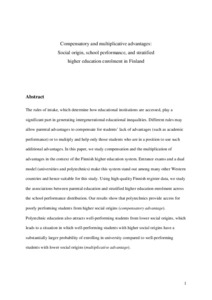Compensatory and Multiplicative Advantages: Social Origin, School Performance, and Stratified Higher Education Enrolment in Finland
Elina Kilpi-Jakonen; Jani Erola; Laura Heiskala
https://urn.fi/URN:NBN:fi-fe2021042823834
Tiivistelmä
The rules of intake, which determine how educational institutions are
accessed, play a significant part in generating intergenerational
educational inequalities. Different rules may allow parental advantages
to compensate for students’ lack of advantages (such as academic
performance) or to multiply and help only those students who are in a
position to use such additional advantages. In this article, we study
compensation and the multiplication of advantages in the context of the
Finnish higher education system. Entrance exams and a dual model
(universities and polytechnics) make this system stand out among many
other Western countries and hence suitable for this study. Using
high-quality Finnish register data, we study the associations between
parental education and stratified higher education enrolment across the
school performance distribution. Our results show that polytechnics
provide access for poorly performing students from higher social origins
(compensatory advantage). Polytechnic education also attracts
well-performing students from lower social origins, which leads to a
situation in which well-performing students with higher social origins
have a substantially larger probability of enrolling in university
compared to well-performing students with lower social origins (multiplicative advantage).
Kokoelmat
- Rinnakkaistallenteet [19249]
